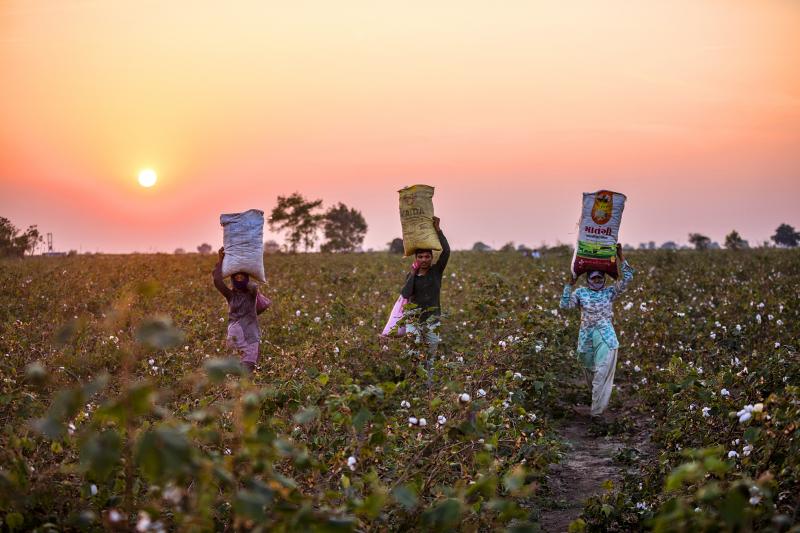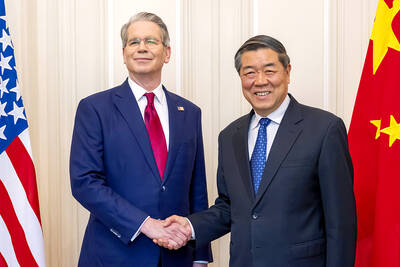As a traditional cotton spinner working from home in her village in northern India, Anita Devi was long resigned to having sore hands, meager income and a constant struggle to make ends meet.
Devi’s life changed in 2019 when the mother of two received a solar-powered spinning wheel, or charkha, as part of a drive by the state of Uttar Pradesh to boost rural women’s work opportunities and incomes in an environmentally friendly manner.
The solar charkhas — which feature 12 spindles, double the number on her old wheel — are equipped with a motor and battery pack, and provided along with a 400 watt solar panel.

Photo: Bloomberg
Devi, 34, produces up to 1.5kg of cotton yarn daily using her solar charkha, up from 400g she spun with a traditional wheel, which has led to a more than fourfold increase in her monthly earnings — now at least 10,000 rupees (US$125.12) on average.
“With the additional income we can afford better nutrition, healthcare and even tuition for my children,” she said at her home in Phoolpur in Moradabad district.
She is one of about 4,000 women across villages in Uttar Pradesh — India’s most populous state and one of the poorest — who have been trained to use and provided with the solar charkhas in the past few years under the state government initiative.
As India seeks to use less planet-heating coal to generate electricity and raise its renewables capacity to 500 gigawatts (GW) by 2030, up from about 115GW, Uttar Pradesh is looking to solar energy to power businesses, homes and communities, with a growing focus on those that are not connected to the grid.
Since 2018, solar charkhas worth 50,000 rupees have been distributed to about 1,000 women annually in Uttar Pradesh for free by the state’s Khadi and Village Industries Board (UPKVIB).
Many women work at home, while others do so at production hubs in their villages which are run by local nonprofits.
Millions of people across India — mainly women from marginalized communities — do home-based textile work, but tend to go under the radar and miss out on minimum wage and benefits.
Navneet Sehgal, additional chief secretary at UPKVIB, said that persuading rural and “patriarchal” households to allow women to attend solar charkha training had proved a challenge initially — but the project was thriving after a slow start.
“It is so satisfying to see their numbers grow — on how they are working with confidence, enjoying more self-esteem and a bigger say in running their households,” he added.
The project in Uttar Pradesh followed a separate nationwide 2018 scheme nationwide project, “Mission Solar Charkha,” with the aim of providing the wheels to create jobs for up to 100,000 people — from spinners to stitchers — in 50 areas or “clusters” across India.
In Uttar Pradesh’s independent program, the solar charkhas are distributed through several grassroots nonprofits.
One of them, Avad Yuva Kalyan Gramodyog Sansthan, also pays the women for the yarn they provide and has it woven into khadi — a traditional handspun fabric — by other female workers in its network before the items are finished off and then sold on.
“There is more awareness among these women today — be it either on ... collective saving, helping each other during crisis, or sharing a line or two on the importance of solar energy in their lives,” its founder Anil Kumar Singh said.
UPKVIB said it gives financial aid to such organizations to ensure production is sustainable, and also helps them to showcase and sell their products at events across the country.
Local clothing companies such as Greenwear Fashion are also playing a role by training and employing hundreds of women to use not only solar-powered charkas, but also looms and sewing machines, as well as by buying “solar yarn” in bulk.
“It is not about making money alone, but our business should also come with a sustainable price tag of keeping the environment clean,” said Abhishek Pathak, founder of the social enterprise, which hails its entirely solar-focused value chain.
Rabia Khatoun, a weaver hired by the company during a COVID-19 lockdown in 2020 and provided with a solar-powered loom at a production center it runs in Sarthara, said she had doubled her productivity — and income — due to the equipment.
“Greenwear employed me during that crisis period, trained me on the use of solar loom and enabled me to sustain myself and my family,” said Khatoun, who added that she was earning 10,000 to 12,000 rupees per month.
It is not just cotton spinners and weavers who are benefiting from solar energy in Uttar Pradesh.
Owners of small businesses, including oil and rice mills and an eatery, said they had got a boost from solar power after using government-backed start-up bank loans, facilitated by UPKVIB, to fund their enterprises.
In Purey Udai in Gonda district, Sangita Devi’s restaurant runs off 5 kilowatt capacity solar panels, which power the lighting, five fans, a refrigerator and a submersible pump that draws underground water.
“My electricity bills are reduced to less than half, and with no more diesel costs, I could not have asked for more,” she said, adding that her profits had more than doubled using the panels.
The Uttar Pradesh New and Renewable Energy Development Agency (UPNEDA) said it had installed about 700 megawatts (MW) of solar off-grid capacity. Its total solar capacity state-wide is 2,200MW.
Such off-grid installations include light for 60,000 homes in a dozen villages where grid power is hard to access, 300,000 street lights and 20,000 irrigation pump sets for farmers.
“Off-grid solar applications can fit well into area-specific needs and penetrate any nook and corner of remote terrains,” said Shyam Dhar Dubey, senior project officer at UPNEDA.
However, Dubey said the high cost of maintaining solar panel systems could be a barrier to their long-term sustainability.
Nonetheless, in the case of the solar charkhas initiative, he hailed their effects on local women in a short space of time.
“Little did I realize that these could thus transform the lives of our rural women, making them self-reliant and environment-friendly,” he added.

France cannot afford to ignore the third credit-rating reduction in less than a year, French Minister of Finance Roland Lescure said. “Three agencies have downgraded us and we can’t ignore this cloud,” he told Franceinfo on Saturday, speaking just hours after S&P lowered his country’s credit rating to “A+” from “AA-” in an unscheduled move. “Fundamentally, it’s an additional cloud to a weather forecast that was already pretty gray. It’s a call for lucidity and responsibility,” he said, adding that this is “a call to be serious.” The credit assessor’s move means France has lost its double-A rating at two of the

AI BOOST: Although Taiwan’s reliance on Chinese rare earth elements is limited, it could face indirect impacts from supply issues and price volatility, an economist said DBS Bank Ltd (星展銀行) has sharply raised its forecast for Taiwan’s economic growth this year to 5.6 percent, citing stronger-than-expected exports and investment linked to artificial intelligence (AI), as it said that the current momentum could peak soon. The acceleration of the global AI race has fueled a surge in Taiwan’s AI-related capital spending and exports of information and communications technology (ICT) products, which have been key drivers of growth this year. “We have revised our GDP forecast for Taiwan upward to 5.6 percent from 4 percent, an upgrade that mainly reflects stronger-than-expected AI-related exports and investment in the third

Mercuries Life Insurance Co (三商美邦人壽) shares surged to a seven-month high this week after local media reported that E.Sun Financial Holding Co (玉山金控) had outbid CTBC Financial Holding Co (中信金控) in the financially strained insurer’s ongoing sale process. Shares of the mid-sized life insurer climbed 5.8 percent this week to NT$6.72, extending a nearly 18 percent rally over the past month, as investors bet on the likelihood of an impending takeover. The final round of bidding closed on Thursday, marking a critical step in the 32-year-old insurer’s search for a buyer after years of struggling to meet capital adequacy requirements. Local media reports

RARE EARTHS: The call between the US Treasury Secretary and his Chinese counterpart came as Washington sought to rally G7 partners in response to China’s export controls China and the US on Saturday agreed to conduct another round of trade negotiations in the coming week, as the world’s two biggest economies seek to avoid another damaging tit-for-tat tariff battle. Beijing last week announced sweeping controls on the critical rare earths industry, prompting US President Donald Trump to threaten 100 percent tariffs on imports from China in retaliation. Trump had also threatened to cancel his expected meeting with Chinese President Xi Jinping (習近平) in South Korea later this month on the sidelines of the APEC summit. In the latest indication of efforts to resolve their dispute, Chinese state media reported that